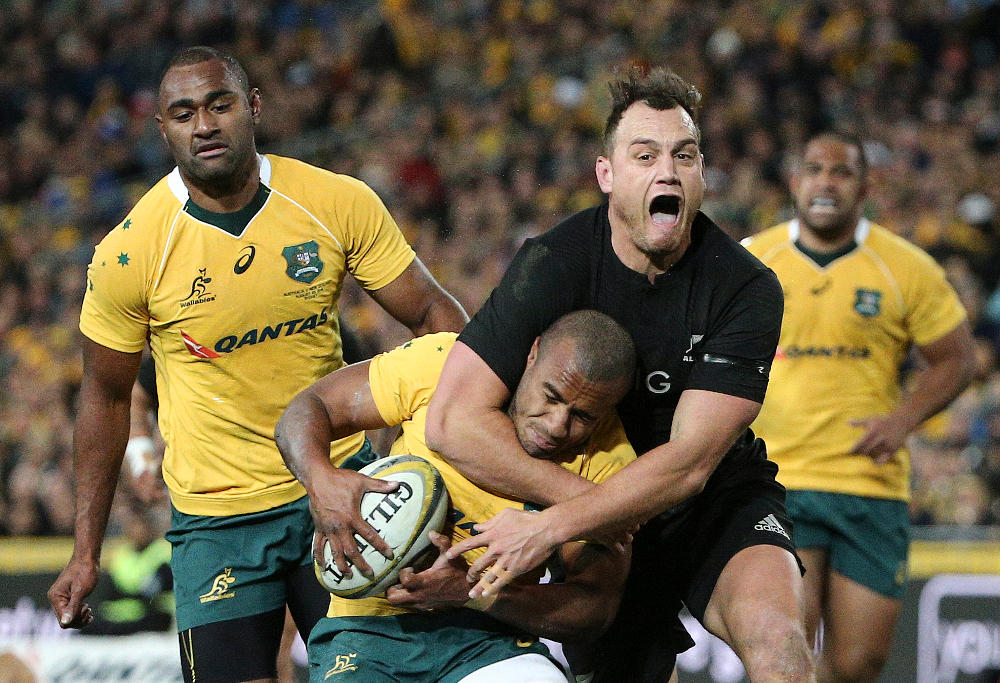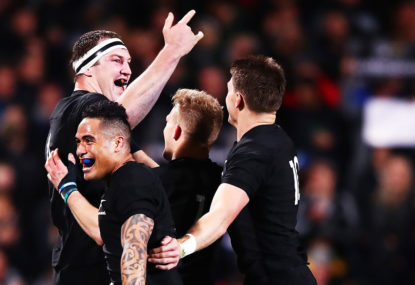The rush defence trialled by the Hurricanes in Super Rugby was basically a testing ground for the All Blacks brains trust before they implemented it with the national team – of this I am almost sure.
The All Blacks have had a lot of success with it and the British and Irish Lions, in turn, used it successfully against them. Time to put it this very simple method under the microscope.
The rush
As with the All Blacks’ attack, the rush defence is very simple to grasp. The first three players either side of the breakdown rush up very quickly in an umbrella fashion which sees the outside defender in this team of three lead the way.
Very importantly, the pillar and post players immediately left and right of the breakdown do their primary role first, which is to cover the channel on either side of the ruck and they only move when the ball has been passed off to the first receiver.
This movement usually involves some degree of lateral movement to help the defender immediately to their outside make a tackle or to tackle the ball runner who steps into that channel.
The point of this rush defence is to put a heap of pressure on the first and second receiver in their attempts to get the ball on the outside of this three-man rush defence, such as wide to their backs. The handling and timing of these receivers needs to be spot on and there is no room for error for want of a dropped ball or a stray pass.
I am sure the All Blacks are conscious of the fact that most, if not all, teams’ first and second receivers, and especially their forwards, do not have the spur-of-the-moment distribution skills to get the ball past the three-man rush defence.
The option most teams then take is to step back inside or even to do a pop pass immediately either side of the ball runner or receiver for a hit up (I have seen this from the Wallabies) and this is exactly what the All Blacks want – keep the attack stifled in a narrow channel without the need to run around or backpedal too much.
The magic of this three-man rush is that, as the attack continues, turns have to be taken by the players in the defending line to be part of this three-man rush defence hence spreading the load. As with their attack, this is energy-efficient defence.
Another option opposition teams take against this defence is to chip over the top to kick long. Again, this is a win for a defensive team because possession is almost always regained. The chip kicks can be made to be contestable but the kick needs to be spot on and performed under pressure (a skill I have not seen executed by too many fly-halves who have come up against this rush defence and certainly not by Bernard Foley).
The scrumhalf, among others, is always roaming behind this rush defensive line to gather any chip kicks. And on a side note, how many times do you see the chip kick chaser run into a defender holding his ground, fall down while putting his hands up the air with a look of disgust on his face and not get anything from the referee?

(Photo by Matt King/Getty Images)
The rushing All Black defenders are excellent tacklers in general and I have noticed that even if they don’t make the actual tackle, they hang onto anything they can get hold of to slow down the ball carrier.
Even if the tackle is missed, the ball carrier is slowed down considerably by either having to crash over a tackler or by having to change their angle and reduce their speed to get past him, which makes picking him off by the second defender much easier and less physically taxing.
The spread
The All Blacks are also very comfortable having a decent amount of space between the players in their general defensive line. This is due to their strategy of not committing numbers to breakdowns but rather spreading their defenders out in the defensive line across the field as quickly as possible.
The one or two players who do commit to the breakdown do their utmost to slow the opposing team’s ball down for that extra second to allow their defenders that extra second to realign. Their 7 is so vital to their defensive system, and this is why the All Blacks will never abandon their traditional 7, even if the new law variations are brought in.
Think the perennial pest that Richie McCaw was. A massive improvement in the All Blacks’ defence since the Richie McCaw days has been that all their forwards and backs are now coached to engage in this type of boundary-pushing slowing down of the ball at the breakdown.
The other reason for the slowing down of the ball is, like with their attacking structure, energy efficiency. Having your defenders backpedal at a slower rate saves a lot of energy and anyone who has had to defend an attack for a long time knows how much it saps your legs if the other team gets a roll on and you have to backpedal quickly.
The All Blacks also always have sweepers in behind their general defensive line and often this is the scrumhalf. These slight of frame and quick-footed players always hover in behind and are excellent at making low cover tackles. Having said that, a lot of their forwards, usually the 7, also perform this role.
The All Blacks also have a habit of rushing the ball carrier from the outside and inside at a very well-paced run in their general defence. If it is identified that the ball carrier is running at a particular defender, the defenders to the immediate inside and outside of that defending player move inwards to close in on the ball carrier.
They move slowly at first, but once it is too late for the offload and the ball carrier is committing to the run, the inside and outside defender rush inwards at pace to help make the tackle and even try for a rip. After the ball carrier is on the ground, only one player usually remains to assist the tackler and to slow down the ball while the other guy immediately resets in the line.
I know from connections in New Zealand that the All Blacks are very comfortable in utilising this spacious, non-committal defence because they know that the attacking team is eventually going to make an error. The amount of technical work that goes into the breakdown (and the laws around it) puts the onus on the attacking team not to mess up and at some point, a cleanout will be missed by a fraction, opening a turnover opportunity. The All Blacks just hang back, slow the ball down for a split second, realign and wait for the next attack and inevitable error.
The early set-up
When a call is made by a first receiver or the receiver outside him on how that attack from a breakdown will play out, it must be remembered that the position of their chests, feet and their general positioning gives away what angles they are going to run and the possible moves available to them.
Having said that, another noticeable trait in the All Blacks’ general defence is that the defender on the inside is always responsible for calling the structure of the defensive line utilises at that particular moment. I can’t comment on the information that comes in from the outside but I can only surmise that there is some communication informing of how the opposition players outside that first defender are set up.
The first player in the defensive line sets himself up almost immediately to face either straight, to the inside or to the outside and all the players outside him follow his lead. This decision is made before the ball even reaches the hands of the first receiver.
They don’t waste time doing it waiting for the ball to leave the first receiver’s hands. This first defensive player will then run up at that angle and so will the others outside him. This requires very quick summarising of the situation from that player (and also from the players outside him that are informing him).

(AP Photo/Rob Griffith)
The goal of this very early decision making, and running up in the way that is immediately selected by the inside defender, is that they are set up before the attack even starts and when the ball leaves the first receiver’s hands they are already running up at the angles required to deal with what’s in front of them.
Conversely, it pressures the offence because they either run into a defensive line ready to deal with how they are set up or they have to change their calls or running angles at the last minute – which almost always ends in disaster.
Where to attack?
Going wide of the three-man rush defensive line to the backline requires great skill and sleight of hand. I have seen very few instances where this has been achieved and almost none by the Wallabies. Running back into the rush defence towards the breakdown plays into the hands of the defending team.
A second receiver, like a 15, running wide and behind the attacking line is an option. I have seen teams use this but I have also seen the fourth or fifth defender out rush up and hit this player – I saw this defensive ploy numerous times from the Hurricanes.
A long pass means that ball is in the air for a longer time which gives the fourth or fifth defender out more time to rush and meet the man when the ball gets to him.
There is not much to do in general play attack where the All Blacks just don’t commit, spread and set up very early. The entire width of the field is covered and running straight at them results in a two to three man gang tackle.
You have to be a vastly superior sized human being to make dents on your own in the defensive line these days because of the size parity across the first tier teams. I always chuckle at the Springboks just swinging it from side to side with no go forward in the name of running rugby because they can’t identify any gaps across the width of the field in the All Blacks’ defence.
The solution for my mind is incredibly simple. The Pumas have shown it on more than one occasion against the All Blacks and the All Blacks did it to the Lions in the first Test when the Lions made it public that they would be using the same rush defence.

(AAP Image/SNPA, Ross Setford)
Just pick and go around the ruck and stick to one-out runners of 9. The Pumas and All Blacks made massive metres up the field when they used it. This is the downside to the rush and spread defence – you can’t defend in close if the other team chooses to commit numbers to attack there.
The defence will have to start committing their forwards in close and spread their backs more thinly across the field. It’s good old fashioned simple rugby – hit them hard in and around the breakdown, force their forwards to come in close and then swing it to your backs to attack.
Problem is, although there is more space, it’s still an even numbered attack with seven backs on seven backs and does the other team, especially the Wallabies, have the backs to do it?
































































































